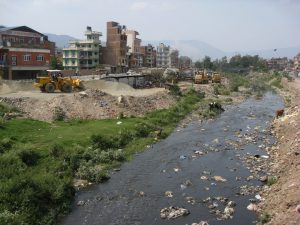The issue of India’s reliance on fossil fuels, especially its coal-fired power plants, is usually a hot potato the country must deal with during UN climate change summits. But even as India promises to adopt clean coal technologies to maintain a balance between environmental conservation and development, a recent analysis shows that India’s coal sector – accounting for more then 50% of the nation’s greenhouse gas emissions (1.05 billion tonnes) – needs to clean up its act.
Analysis by the Centre for Science and Environment (CSE), a Delhi-based think-tank, indicates that the country’s coal-based power sector is set to avoid compliance with the new emission norms that will come into effect from December this year.
The norms were put in place on 7 December 2015 by the Ministry of Environment, Forests and Climate Change (MoEFCC) to regulate air pollution and water withdrawal due to the sector’s inefficient operations. Of the total emissions from the industrial sector, the power sector alone contributes to 60% of the PM (particulate matter – of all dimensions), 45% of the SOx (sulphur dioxide), 30% of the NOx (nitrogen oxides) and 80% of the mercury emissions. India is already the worst emitter of SOx globally.
“A recent study by University of Maryland shows that India contributes to nearly 50% of the world’s SOx emissions, most of it from the thermal power plants,” said Priyavrat Bhati, programme director for energy at CSE. Despite this heavy load of pollutants and the fact that it was given two years to comply with the new emission standards, the industry has done nothing, according to CSE.
The government is, in fact, making it easier for the industry to flout the norms. Instead of pushing the industries to comply, the Ministry of Power (MoP) and the Central Electricity Authority (that also acts as the technical advisor to the power ministry) are trying to push the deadline by five years to 2022 – all while the north of the country grapples with the issue of intense air pollution.
“Another five years to meet these standards is unacceptable. It is important to push for ambitious timelines for compliance with the new norms,” said Chandra Bhushan, deputy director general of CSE. “The environment ministry needs to come up with a tight implementable deadline and a concrete roadmap for each and every plant to ensure compliance. When we talk of air pollution, we talk of dust, automobile pollution, crop burning and industrial pollution, but we also need to talk about thermal power plants.”
As per the new standards, power plants installed before December 2003 have to maintain PM at 100mg/Nm3. Those installed between 2004 and 2016 have to maintain PM at 50mg/Nm3 from December this year. The SOx norm is same for both the categories; 600mg/Nm3 for less than 500 MW plants and 200 for those greater than 500MW. The new NOx limit has been set at 600mg/Nm3 for the power plants installed before December 2003 and 300mg/Nm3 for those set up between 2004 and 2016. There are tougher standards for new plants that have been built from 2017 onwards.
If the new norms are followed then the major pollutants from coal-based power plants such as SOx and NOx can be cut by 70-85%, a major boon to the environment.
But the CEA and MoP have been resisting implementation, citing reasons such as high capital costs, lack of availability of technology, lack of technology suppliers, impact on tariff and lack of space to install technologies like flue gas de-sulpurisation (FGD) that reduces SOX emissions in the premises. But CSE’s study debunks them as non-serious impediments and calls it “a classic case of one ministry proposing and the other disposing”.
The CSE report, based on detailed analysis of 47 plants that produce 54 gigawatts, says that CEA’s claim of high capital costs are exaggerated and most of the plants have not even assessed what all pollution control technology is needed. For example, the CEA is asking all plants to install FGD but it is not needed in smaller and older units in any case. Plus, controlling NOx emissions only requires boilers ot be upgraded which can be done as part of routine maintenance work. As per the Central Pollution Control Board, about 50% of the capacity is already complying with NOx norms and hence the remaining can be met without the extension of deadline. The study also mentions that “CEA’s own report suggests about 65% of the capacity already meets PM standards but these plants should provide evidence of compliance”. It suggests that remaining plants can meet the NOx standards by March 2019 and SOx standards by December 2020.
Experts also say that the lack of space for technologies is an invalid excuse as all plants built after 2003 were given environmental clearance on the condition that they will keep the space to install FDG – not having it is a legal violation. The CSE has also submitted a phase-wise implementation plan to the MoEFCC and has recommended that an aggressive timeline needs to be pursued.
“To ensure that there are no further delays, the environment ministry should back these timelines with penalties and bank guarantees,” said Bhati. Experts fear that the power sector is just buying time and would again build a case for further extension of deadlines in 2020.
Bhushan added: “[The CEA proposal to implement the standards by 2020) is heavily back-loaded. Most plants will do nothing for the next two-to-three years. They will start putting equipment only from 2020 onwards.” He also said that in 2003 coal power sector had voluntarily promised to improve their pollution load and that the new norms are the same as what the sector had proposed then. “So this is something that they should have done more than a decade ago and they shouldn’t be given any further extension.”
The analysis of half of India’s installed thermal power capacity shows that the Indian coal-based plants are working at a poor efficiency level. They use 33% more coal and emit 10% more than those in China. They are big water guzzlers as well. Currently they draw water equivalent to half of the country’s total drinking water needs and use four cubic metres of water for every MWh, while the water used by Chinese thermal power plants is just two cubic metres per MWh. This is despite the fact that China’s installed thermal power capacity is four times that of India.
“We love comparing with China on economic growth but we should also compare ourselves with them on the environment parameters too,” said Bhushan.
We want to hear from you! Tell us what you think about The Third Pole and you could win $100. Take our survey here.
![<p>A coal fired electric plant on the banks of the Chambal river [image by: Carol Mitchell]</p>](https://dialogue.earth/content/uploads/2017/11/coal-plant-Chambal-by-carol-mitchell.jpg)







